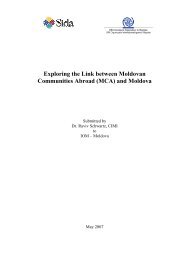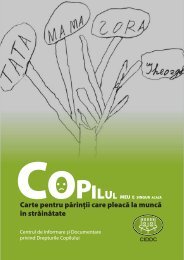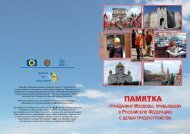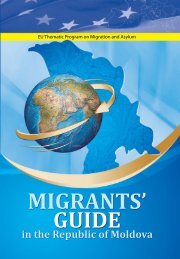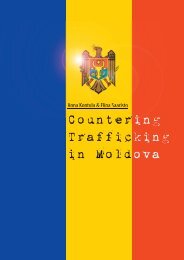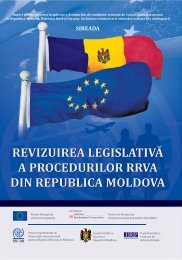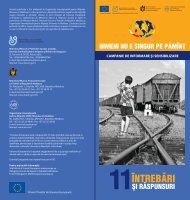Trafficking in Human Beings in Southeastern Europe - Iom
Trafficking in Human Beings in Southeastern Europe - Iom
Trafficking in Human Beings in Southeastern Europe - Iom
- No tags were found...
Create successful ePaper yourself
Turn your PDF publications into a flip-book with our unique Google optimized e-Paper software.
<strong>Traffick<strong>in</strong>g</strong> <strong>in</strong> <strong>Human</strong> Be<strong>in</strong>gs<strong>in</strong> <strong>Southeastern</strong> <strong>Europe</strong>Bulgaria• Young women, rarely under 18, who come from big and smaller citiesand to a lesser extent from villages. Traffickers make contact withthem directly or through peers, rarely through their families;• Young women who answer job advertisements offer<strong>in</strong>g them attractivejobs as models, dancers, au pair, etc;• Sex workers;• Girls from the Roma m<strong>in</strong>ority, who are often under 18 and are oftensold to traffickers by their families;• Teenage girls are often kidnapped.As <strong>in</strong> other countries, the data on traffick<strong>in</strong>g is usually fragmentary and<strong>in</strong>complete. Accord<strong>in</strong>g to the statistics of the border police, only 10 percent ofthe trafficked women stopped at the border are Bulgarian. However, theseparticular statistics refer only to women who are try<strong>in</strong>g to leave Bulgaria withoutvalid documents. It shows that the law enforcement authorities tend toattach the word “trafficked” to data on female migrants who have beenstopped at the border. 64 Other statistics show the number of illegal femalemigrants deported to Bulgaria. In 2000, 679 Bulgarian women were deportedback to the country, the majority from Germany, Poland and Greece. 65Reliable statistics and their analysis can only be based on the actual caseloadof trafficked persons assisted by IOM Bulgaria. Dur<strong>in</strong>g the period March 2000to August 2001, IOM Sofia assisted 63 cases of trafficked women and girls.Thirty-five women were of Bulgarian orig<strong>in</strong>, returned from Kosovo, FYR Macedonia,Albania, Italy and Spa<strong>in</strong>. The profile of trafficked women from Bulgariabased on the 35 assisted cases is as follows:• Age breakdown: 56 percent are aged between 20 and 25; 12 percentbetween 25 and 30; and 8 percent are under 20 (of whom only one<strong>in</strong> the sample was under 18). Another eight percent are over 30 yearsold;• Background: 53 percent of the victims come from the big cities and40 percent from smaller cities of Bulgaria. Eight percent have universityeducation and forty percent high school education, <strong>in</strong>clud<strong>in</strong>g eightpercent that have f<strong>in</strong>ished Professional school. Thirty six percent haveonly f<strong>in</strong>ished primary school; eight percent have not completed secondaryeducation;• Twenty eight percent of the women report hav<strong>in</strong>g had difficult to badfamily relations <strong>in</strong> their childhood or before be<strong>in</strong>g trafficked;• Way of recruitment: 56 percent of the girls have been lured throughfalse job promise; 24 percent through false <strong>in</strong>vitation for visit, marriageor tourism; and 20 percent are kidnapped;• In the majority of cases, the recruiters are men (12 male recruitersand only three female) of Bulgarian, Albanian or, <strong>in</strong> only one case, ofMacedonian orig<strong>in</strong>;• Conditions of life and work while trafficked: only eight percent ofwomen had freedom of movement and it was denied completely for84 percent. Seventy six percent received no payment for their services;eight percent received <strong>in</strong>cidental payment and only eight percentwere paid regularly.1.1.2. Foreign women and girlsIn the past few years, Bulgaria has also become a country of transit and dest<strong>in</strong>ation.Dur<strong>in</strong>g the summer season, women from Romania and countries ofthe former Soviet Union work <strong>in</strong> the sex <strong>in</strong>dustry <strong>in</strong> the area of the southernborder. This shift from be<strong>in</strong>g a country of orig<strong>in</strong> to one of dest<strong>in</strong>ation is due to5264.Interview with a Border Police officer, Sofia, 5 August 2001.65.Information provided by the National Co-ord<strong>in</strong>ator to the Stability Pact Task Force, 2001.



